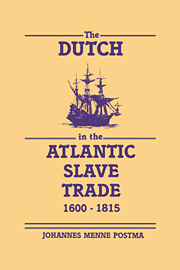Book contents
- Frontmatter
- Contents
- List of tables, figures, and maps
- Preface
- 1 Foundations of the slave traffic, 1600–61
- 2 Curaçao and the asiento trade, 1650–1730
- 3 The Dutch on the West African coast
- 4 Trade and politics on the African coast
- 5 Volume of African exports and origins of slaves
- 6 Organization and mechanics of the trade
- 7 The triangular trade
- 8 The Dutch plantation colonies under WIC monopoly, 1618–1738
- 9 The era of the free trade, 1730–80
- 10 The slaves: their treatment and mortality
- 11 Finances, marketing, and profitability
- 12 The end of the Dutch slave trade, 1781–1815
- Appendixes
- Bibliography
- Index
5 - Volume of African exports and origins of slaves
Published online by Cambridge University Press: 16 September 2009
- Frontmatter
- Contents
- List of tables, figures, and maps
- Preface
- 1 Foundations of the slave traffic, 1600–61
- 2 Curaçao and the asiento trade, 1650–1730
- 3 The Dutch on the West African coast
- 4 Trade and politics on the African coast
- 5 Volume of African exports and origins of slaves
- 6 Organization and mechanics of the trade
- 7 The triangular trade
- 8 The Dutch plantation colonies under WIC monopoly, 1618–1738
- 9 The era of the free trade, 1730–80
- 10 The slaves: their treatment and mortality
- 11 Finances, marketing, and profitability
- 12 The end of the Dutch slave trade, 1781–1815
- Appendixes
- Bibliography
- Index
Summary
The question of where the African slaves came from is one of the most perplexing problems in the Atlantic slave trade, one which will probably never be solved to satisfaction. This is largely due to the fact that so little written evidence exists on the trade routes of the African interior. Although recent studies have tried to come to grips with this problem, the internal African markets were by no means static and provide therefore indications only and are of limited value about slave origins. Studies using information on the ethnic origins of slaves in the New World have been attempted, but they too suffer from a lack of comprehensive data. The best contributions this study can offer are to delineate the coastal regions from which the Dutch obtained their slaves and to discuss the qualitative evidence of the ethnic or coastal preferences indicated by Dutch slave traders and colonists in the West.
Demands of the market place
Numerous factors determined where Europeans acquired their slaves. In addition to the availability of slaves, the existing commercial contacts, and the political and economic conditions in a given African region, slaves from certain regions were simply in greater or lesser demand in the colonial markets of the New World. And such preferences might differ from one market area to another, and also from one time to another.
- Type
- Chapter
- Information
- The Dutch in the Atlantic Slave Trade, 1600–1815 , pp. 106 - 125Publisher: Cambridge University PressPrint publication year: 1990



